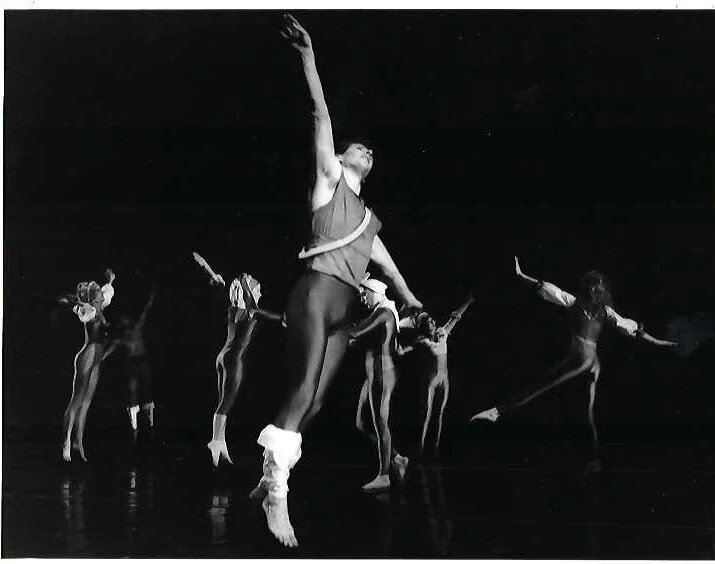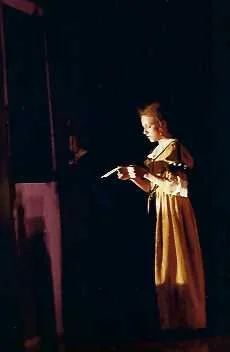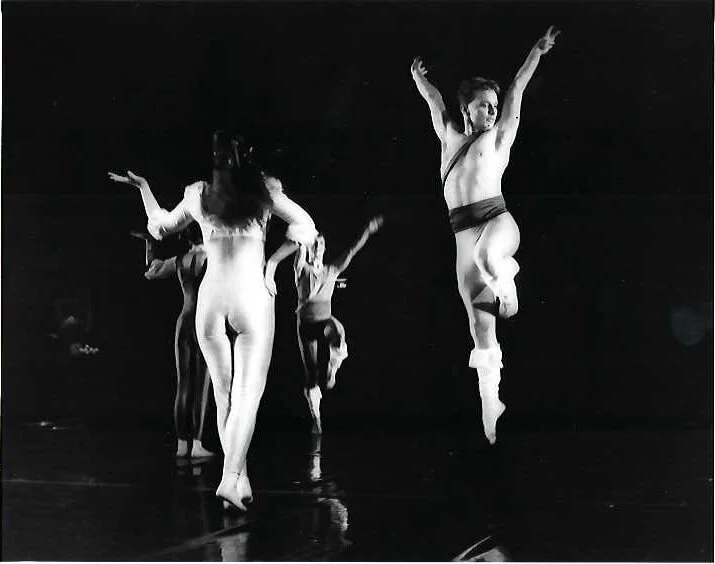Jeanette Duane on the phone, Sandra Sucsy as the table, Linda Spriggs as the picture frame, toward the end of the dance
Vermeer Variations
Premiere: March 20-23, 1986, Power Center, Ann Arbor, MI. University Dance Company. Subsequently performed at The Cunningham Studio, NYC, 1987. Supported in part by a Rackham Faculty Grant.
Duration: 17 minutes
Performers: Gina Alagna, Giles, Brown, Thomas Cocco, Denise Damon, Heidi Durning, Mary Fehrenback, Joy Grad, Jean McGregor-Wiles, Steven Mann, Denize Oktay, Gregory Patterson, Ronna Rochell, Linda Spriggs, Sandra Sucsy, Rebecca Weitz, With Jeanette Duane as the woman at the window, and Alison Alexander as the maidservant pouring milk.
Music: The Vermeer Variations by David Borden
Musicians: John Andre, David Borden, Ann Kozik, Joe Lukasik, Mark Suter, David Swaim
Slide Projections: George Deem
Costumes: Alison Ford
Set: Doug Miller
Lighting Design: Ken Yunker
Description: This large group work built upon ideas from Dance for Ten with Woman at Window, created two years earlier at the University of Rochester, and featured exciting collaborations with composer David Borden and painter George Deem. It was created for UM Dance majors for the Dance Department’s annual major production at Power Center. For this work Borden created a new score, and suggested we collaborate with his good friend, painter George Deem, who reimagined old master works, including several of Vermeer’s most iconic images. I met with Borden and Deem at Deem’s studio in NYC where he showed me his exquisite paintings. Deem often inserted contemporary images into his copies of Vermeer paintings, and sometimes reoriented the spaces within Vermeer’s paintings. Accordingly, I juxtaposed women reading and writing letters with women on phones, using yellow phones with 25-foot long yellow cords that spiraled across the space. For the stage design, Deem took details from Vermeer’s paintings to create five projections, including a stained glass window, a small landscape seen in the background of one of Vermeer’s paintings, a white pitcher, a chandelier, and Vermeer’s signature, and painted them against a black background. These were photographed and projected throughout the dance.At Deem’s request the projections were a little off in their placement within the large volume of the stage space. For example, the landscape was projected a little too high. Deem came to the tech rehearsals to oversee the projections. Women danced with their letters, drank with their male partners, poured water and milk. They danced Vermeer’s signature, employing one of my favorite devices of embedding spellings of words within dances. Dancers became human tables, chairs, pitchers, wine glasses, and even the black and white floor tiles seen in Vermeer’s paintings. Three dancers became a human chandelier, standing back to back and extending their six arms holding out cigarette lighters, an image inspired by Cocteaus’s La Belle et La Bėte, in which human arms come through the walls of the staircase holding candles. Borden’s band played keyboards live,. Costumed in black and white, the musicians were positioned at the back of the stage behind a scrim, looking like the men in a Dutch cigar box. Also behind a scrim, a dancer was positioned as a tableau vivant, pouring milk as in Vermeer’s “The Milkmaid.” At the opening of the dance, a woman dressed in blue sat on a platform playing at a keyboard, as in a Vermeer’s “Lady at a Virginal” , and a cupid figure with bow appeared before the woman was rolled offstage as the dancers entered spelling Vermeer’s name. A quintet of women performed a dance reading and writing letters. A woman (Ronna) carried a bowl , pitcher of water, and turban across the stage and poured water into the bowl, after which a dancer (Jeanette) did a backbend into the bowl to wet her hair and fling it backward before donning a turban. Two dancers as maids dried the floor with rags in circular patters —this was a practicality to wipe up spills of water. A cupid figure with bow appeared a few times, emulating the cupid seen in background paintings in some of Vermeer’s paintings. The cupid passed a love letter to the woman who read it by a window. As I write this, an article appeared in the The New York Times today (9/13/2021) discussing the restoration of “Woman reading a Letter at an Open Window” revealing the large cupid painting in the background that had originally been there and was subsequently painted over. So I must have had a pyschic sense of the connection between the cupid and the woman reading.
I must have asked each cast member to list an outline of their materials within the dance, and some of those notes are linked below. Arthur Ridley, the University Productions meticulous prop master, created a list of props for the dance, linked below (but hard to read!) Rugs, cloths, pitchers, bowls, feather quills, bugle, cupid’s bow, paint brush, clogs, broom, writing paper, table, chair, telephones, cigarette lighters were among the props employed by the cast.
Choreographer notebook excerpts
Prop list, prop master Arthur Ridley, University Productions
Vermeer group traversing zigzag patterns that emulated the patterns of the black and white floor tiles in Vermeer’s paintings, Steve Mann foreground. Ronna Rochell, center, carries bowl and pitcher as dancers move in counter patterns.
Jeanette Duane does backbend into bowl to wash hair.
Jeanette Duane reading a letter at an open window
Giles Brown and Heidi Durning
Heidi Durning facing upstage becoming a pitcher, Giles Brown jumping





